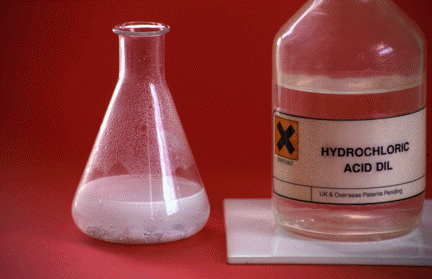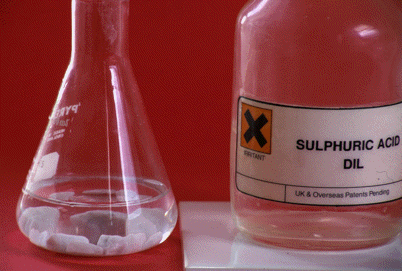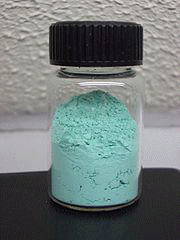Calcium Carbonate Hydrochloric Acid Reaction
Chemguide: Core Chemical science fourteen - 16
Reactions betwixt acids and carbonates
This page looks at the reactions between acids and carbonates to give a salt, carbon dioxide and water.
A summary equation
acid + carbonate
salt + CO2 + water
Reactions involving calcium carbonate
The commonest carbonate-acid reaction yous will come beyond is that betwixt calcium carbonate and dilute hydrochloric acid.
Calcium carbonate occurs naturally every bit chalk, limestone and marble. The photo shows the reaction with marble fries.

You get immediate fizzing with a colourless gas given off - that's carbon dioxide. The marble reacts to give a colourless solution of calcium chloride.
CaCO3(s) + 2HCl(aq)![]() CaCl2(aq) + CO2(g) + H2O(l)
CaCl2(aq) + CO2(g) + H2O(l)
The reaction with dilute sulfuric acrid is slightly more complicated because the calcium sulfate formed is only very slightly soluble.
The reaction starts, but almost immediately stops again because the marble chips become coated with a layer of calcium sulfate which prevents any more acid getting at the marble chip.
The photo shows what the reaction looks like a short time afterward you have added the acid. Nothing is happening.

The ionic equation for the reaction
All carbonates react in the same sort of way and that is because the same underlying bit of chemistry happens in each case.
Carbonate ions from the carbonate react with hydrogen ions from the acid.
COthree two-(s or aq) + 2H+(aq)![]() CO2(m) + H2O(50)
CO2(m) + H2O(50)
The "(southward or aq)" is because a few carbonates (sodium, potassium and ammonium carbonates) are soluble in water, then you might utilise a solution of one of these.
So if you added dilute hydrochloric acrid to sodium carbonate solution, you would over again go carbon dioxide produced - merely this time everything would be in solution.
So what happens to the other ions? They are spectator ions.
In the hydrochloric acid / calcium carbonate case, the chloride ions are at that place in solution all the time. The calcium ions were originally present in the solid and stop upwardly in the solution, but they are still calcium ions.
So the solution contains calcium ions and chloride ions - calcium chloride solution.
The reaction between copper(II) carbonate and dilute sulfuric acid

Copper(II) carbonate is an insoluble green pulverization. This photo comes from Wikipedia.
The next video shows its reaction with dilute sulfuric and, and shows how you can test for the carbon dioxide given off.
CuCO3(s) + H2And soiv(aq)![]() CuSOfour(aq) + CO2(g) + H2O(fifty)
CuSOfour(aq) + CO2(g) + H2O(fifty)
The ionic equation, showing the reaction betwixt the carbonate and hydrogen ions, is exactly the same as before - except, of course, that nosotros know copper(Ii) carbonate is a solid.
CO3 2-(southward) + 2H+(aq)![]() CO2(thou) + H2O(l)
CO2(thou) + H2O(l)
This time the spectator ions y'all are left with are copper(Ii) ions and sulfate ions in solution - blue copper(II) sulfate solution.
Testing for the carbon dioxide
You lot test for carbon dioxide using lime water - a very dilute solution of calcium hydroxide in h2o. Lime water is a colourless solution and turns cloudy ("milky") when carbon dioxide is passed through it.
The calcium hydroxide reacts with the carbon dioxide to give insoluble calcium carbonate - that'southward what causes the cloudiness.
Ca(OH)two(aq) + CO2(k)![]() CaCO3(s) + HiiO(fifty)
CaCO3(s) + HiiO(fifty)
Hydrogencarbonates
Making calcium hydrogencarbonate
If you pass carbon dioxide through lime water for a long time, information technology first goes milky considering of the formation of a precipitate of calcium carbonate, but then the precipitate disappears again giving a colourless solution.
The side by side fleck of video shows this happening. The video is a bit clumsy just is chemically authentic.
The calcium carbonate precipitate reacts with more carbon dioxide to course calcium hydrogencarbonate, Ca(HCO3)2. Calcium hydrogencarbonate is soluble in water.
CaCO3(s) + CO2(thousand) + H2O(l)![]() Ca(HCO3)2(aq)
Ca(HCO3)2(aq)
This is the aforementioned reaction which produces cave systems in limestone rocks. Limestone is a form of calcium carbonate. Carbon dioxide dissolved in rain water gradually dissolves the rock over very long periods of time.
The reaction of hydrogencarbonates with acids
You volition find compounds like sodium hydrogencarbonate as well called "sodium hydrogen carbonate" (dissever words) or the old name "sodium bicarbonate". I prefer the name "sodium hydrogencarbonate" because it shows that the hydrogen and carbonate are both part of the same HCOiii - ion.
There are very few solid hydrogencarbonates - the only ones you are likely to see are sodium and potassium hydrogencarbonates.
Calcium hydrogencarbonate merely exists in solution. If y'all try to turn information technology into a solid, it splits up once again into calcium carbonate and carbon dioxide and water.
Hydrogencarbonates react with acids in the same way as carbonates.
So, for example, if you lot add together dilute hydrochloric acid to solid sodium hydrogencarbonate, it will react giving off colourless carbon dioxide gas and producing colourless sodium chloride solution.
NaHCO3(s) + HCl(aq)![]() NaCl(aq) + COii(g) + H2O(l)
NaCl(aq) + COii(g) + H2O(l)
The ionic equation for the reaction is
HCOthree -(s) + H+(aq)![]() CO2(k) + H2O(50)
CO2(k) + H2O(50)
Note:To be honest, at this level you might come up across calcium hydrogencarbonate being formed in the lime water reaction, and you might come across sodium hydrogencarbonate being used to exam for an acrid. If you add solid sodium hydrogencarbonate to a liquid and go carbon dioxide given off, then the liquid must be acidic.
You might too come up across calcium or magnesium hydrogencarbonates if yous do a topic well-nigh hard water.
And that is about all you will need to know!
Calcium Carbonate Hydrochloric Acid Reaction,
Source: https://www.chemguide.co.uk/14to16/acids/carbonates.html
Posted by: rowlandamited.blogspot.com


0 Response to "Calcium Carbonate Hydrochloric Acid Reaction"
Post a Comment